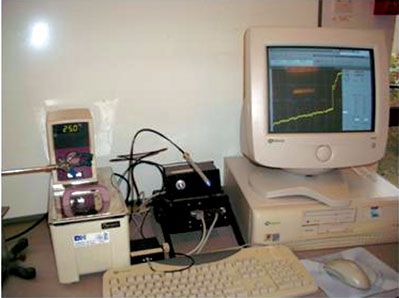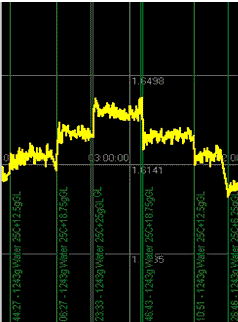| 2006 |

|
YEAR BOOK |
|
Validation of a novel glucose sensor based on the quenching of Ruthinium complex fluorescense by oxigen
|


Validation of sensor behaviour was carried out in Moorepark which included the effect of temperature, ionic strength, ethanol and sucrose. Sensor prototype was installed in Moorepark by SAFIBRA (Prague), see Figure 1. In association with SAFIBRA the prototype was initially tested for temperature effects on fluorescence lifetime and intensity in the presence and absence of oxygen. A linear decrease in both fluorescence lifetime and intensity was observed with increase in temperature (5-40�C). The effect of increasing NaCl concentration (0 � 500 mM) on the fluorescence lifetime and intensity at 22�C was determined and a gradual increase in both lifetime and intensity was observed as the concentration of NaCl increased. This was interpreted as a decrease in oxygen solubility in high salt aqueous solutions resulting in a decrease in fluorescence quenching and an increase in fluorescence intensity.
The effect of ethanol concentration (0 � 14%, w/w) at 22�C on the fluorescence lifetime and intensity was determined. The intensity of fluorescence was reduced as the concentration of ethanol increased. The reduced intensity of fluorescence in the presence of increasing concentrations of ethanol was interpreted as an increase in the solubility of oxygen in ethanolic solutions resulting in increased quenching of fluorescence from the Ru-complex.
Glucose oxidase was incorporated into the sensing lens by the MATINOES group for the specific detection of glucose. Sequential addition of glucose (within the effective range of the sensor, 0 � 3 mM) to water showed a repeatable and rapid response by the sensor (Figure 2). This suggested that the permeability of the lens to both glucose and oxygen was adequate. Sequential dilution of the spiked solution showed that the ability of the lens to recover was also rapid and repeatable.
A linear response in fluorescence lifetime increase was observed between 0 � 3 mM glucose. Repeatability of the standard curve was good. This effectively meant that 0.1 � 0.5% glucose solutions could be measured accurately, and that the sensor is capable of detecting such glucose concentrations in a variety of food solutions.
Contact: Dr Brendan O'Kennedy
Tel: 025 42446
E-mail: [email protected]